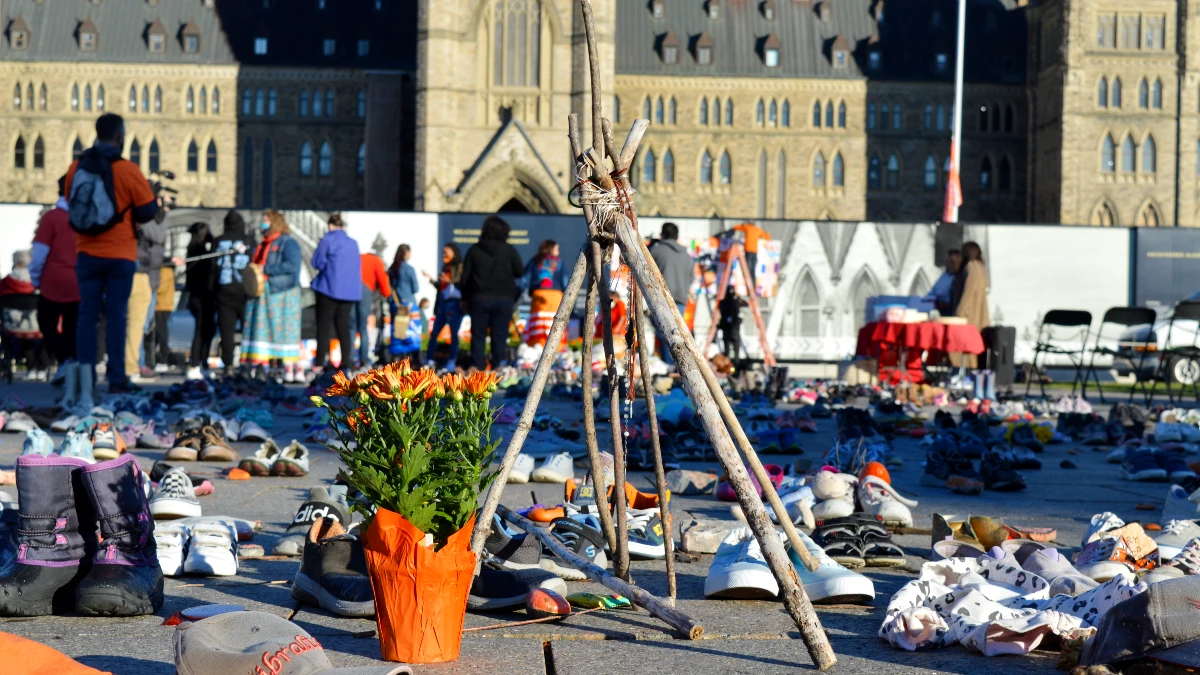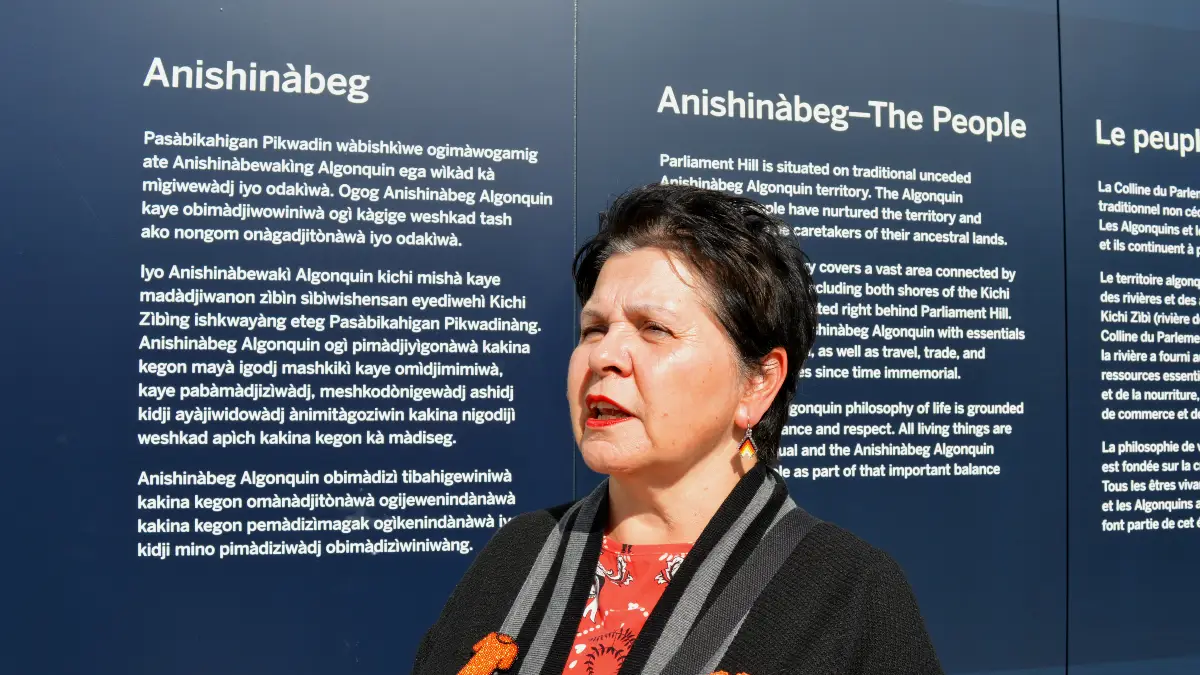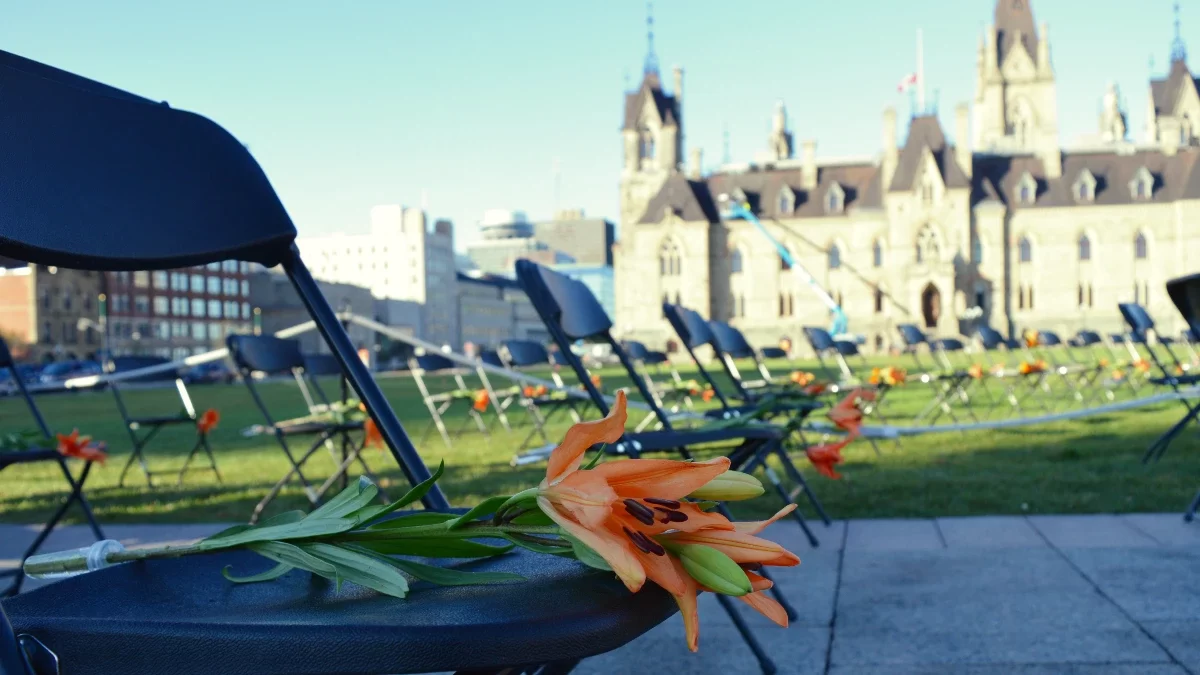Flowers, teddy bears and children’s shoes lined the steps of Parliament Hill on the morning of Sept. 30, Canada’s first National Day for Truth and Reconciliation.
The lawn in front of the Parliament Buildings and the area around the Centennial Flame became a sea of orange as Indigenous and non-Indigenous people commemorated the lives and cultural traditions lost in residential schools, during the Sixties Scoop and other assimilative projects of the Canadian state.
Elders and survivors sat in rows of chairs reserved by orange lilies. Though hundreds attended the Remember Me event, Ottawa’s downtown core was silent.
The commemoration began with an offering of eagle feathers to survivors of residential schools. Eagle feathers are sacred and must be earned in Anishinaabe and other Indigenous cultures.
Drummers, singers, poets and activists performed throughout the morning, inviting the crowd to join in “decolonized” silent moments remembrance accompanied by drum beats, prayers and songs.


The National Day was proposed in 2015 by the Truth and Reconciliation Commission as one of its 94 calls to action. Now, for the first time in Canadian history, the day was being recognized by the federal government.
But five provinces — Ontario, Quebec, Alberta, British Columbia and Prince Edward Island — have yet to formally recognize the day as an official holiday.
1,300 and counting
More than 150,000 Indigenous children attended residential schools before the last one closed in 1997, according to the National Centre for Truth and Reconciliation.
In spring 2021, members of the Tk’emlups te Secwepemc First Nation found 215 unmarked graves at the former Kamloops Indian Residential School in B.C.
In the following months, Indigenous organizations and police discovered more than 1,300 unmarked graves on and near the grounds of former residential schools. Many sites remain unsearched.
Canada started the residential school system in 1883, following passage of the Indian Act, with a general purpose of assimilating Indigenous children by taking them away from their families.
The residential school program was funded and run by Christian churches. The schools are infamous for a history of abuse and neglect. Duncan Campbell Scott, a high-ranking public servant and a principal architect of residential schools, is known to have articulated the policy as intending to “kill the Indian in the child,” according to the Canadian Encyclopedia.
The TRC report from 2015 outlined the horrific abuse children faced at the hands of nuns, priests and teachers at the schools. “Children were abused, physically and sexually, and they died in the schools in numbers that would not have been tolerated in any school system anywhere in the country, or in the world,” the report stated.
Survivor’s story
Doug George-Kanentiio is a survivor of the Mohawk Institute, a residential school outside of Toronto. At the Remember Me event, he recounted his story of escape. He and his friends had defied the authority of the residential school and caused so much commotion they were expelled.
“I can say with absolute pride . . . we young Akwesasne Mohawk boys — called the St. Regis Boys — were the only ones as a group in the history of the residential school system to be collectively expelled from one of those places,” he said. His statement was met with a thundering applause from the crowd.
Joey Commanda, 13 years old at the time, was sent back to the Mohawk Institute and attempted to follow in his friends’ footsteps to return home. In an escape many others would not survive, a 450-kilometre journey from the Mohawk Institute to Golden Lake, near Pembroke, he was hit by a train. His brother, Rocky, was apprehended by Ontario police.
“[Joey Commanda] died in an attempt to return back to the embrace of his family,” said George-Kanentiio.
On Aug. 26, George-Kanentiio and Joey Commanda’s family returned to the grounds of the Mohawk Institute, along with a detective from the Six Nations’ police, Woodland Cultural Centre and Survivors’ Secretariat.
“We found those places where the children are buried at the institute,” said George-Kanentiio. “We could feel their spirits beneath our feet.”
Turning a blind eye
Gail Clark, a non-Indigenous woman, arrived at Parliament Hill early Thursday morning, well before the beginning of the event. Clutching her coffee, she stood quietly in front of the Centennial Flame and made way for Indigenous survivors, elders and activists as they walked to the podium and seating area. Clark said she was aware of her presence as a non-Indigenous attendee of the event.
Though residential schools existed in communities across Canada until the late 1990s, many non-Indigenous Canadians did not realize the severity of this issue.
Clark grew up in a small community in Nova Scotia and said she would pass by the Shubenacadie Indian Residential School while on her way to visit her grandparents.
“All we would do is say, ‘Oh, the Indians are going there,’ but we didn’t know (about the abuse),” Clark said.
In the 1980s, she worked as a registered nurse in Northern Manitoba and said she had no idea about the harms inflicted by Indian Residential Schools until later in her adult life.
Clark recalls seeing stereotypes about Indigenous peoples in her work as a nurse, as well. Many nurses and medical workers believed Indigenous peoples did not know how to take care of themselves. “We went in (to work) without any kind of cultural education at all,” she said.
“This has been building all my life. I have every reason to be (at the Remember Me event) because this is my history and I have to be a part of the reconciliation process as an ally and as a human being.”
‘Honouring the truth, reconciling for the future’


Algonquin Anishinaabe Elder Claudette Commanda is the executive director of the First Nations Confederacy of Cultural Education Centres. She was a speaker at the Remember Me event and said the National Day for Truth and Reconciliation marks a new beginning for Canada.
During the morning, she made her way through the crowd and acknowledged Indigenous community members and youth, often greeting them like family. On many instances, she paused an interview or speech to call out to community members and children, making clear her support for them.
Commanda said Canadians and settlers should use the new statutory commemoration day to embark on a journey to learn about Canada’s history of colonization. She said she was pleased that hundreds of people showed up at the Remember Me event. But she emphasized that these actions and efforts cannot stop when the day is over.
‘Every day has to be Truth and Reconciliation Day. Every day has to be Sept. 30. Every day has to be (Orange Shirt Day). It is the only way this country, Canada, is going to heal.’
Elder Claudette Commanda
Commanda said she was attending and speaking at the event to mourn with families of the children who never made it home from residential schools, for the survivors who did make it back after witnessing and experiencing traumatic events, and for the children who suffered intergenerational trauma as a result of residential schools. But she said she was also participating for more than that.
“I’m also here to rejoice with (Indigenous peoples’) strength and resilience, that they are here and they have survived,” Commanda said. “We will continue to survive, but today is a new beginning. It’s a day to turn the page and make a new history.”




